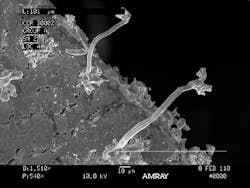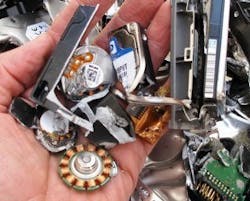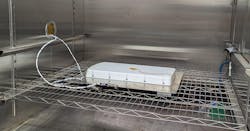By Dan Friedlander
Retired following 44 years in components engineering
The extent of the e-waste issue can be seen through The World Counts (http://www.theworldcounts.com/) World Waste Figures (2014): - A culture of use and throw away generates around 40 million tons of e-waste every year, worldwide. - E-waste comprises 70 percent of overall toxic waste. - E-waste contains hundreds of substances, of which many are toxic. This includes mercury, lead, arsenic, cadmium, selenium, chromium, and flame retardants. - Only 12.5 percent of E-Waste is recycled. - Eighty (80) percent of E-Waste in the U.S. and most of other countries are transported to Asia or Africa. E-Wastes are buried or incinerated in landfills where their toxins pollute our land, air, and water.
The above dramatic figures point to a serious threat to environment and health. Indeed, the huge consumer/commercial quantity of thrown-away electronic products are difficult to be managed.
Nevertheless, the conclusion to ban use of lead (Pb) in electrical, electronic, and electromechanical (EEE) components is controversial. Same goes for the Pb impact on health and environment. The balance between the achieved benefits and the associated detriments is also controversial.
According to Wikipedia, "less than 4 percent of lead in landfills is due to electronic components or circuit boards, while approximately 36 percent is due to leaded glass in cathode ray tube monitors and televisions, which can contain up to 2 kilograms per screen."
The very same issue is presented differently by Andrew D. Kostic, Ph. D. of The Aerospace Corporation in his presentation "Lead-free Electronics Reliability - An Update," August 2011.
It is interesting to see the below presented facts versus the dramatic steps taken through banning the use of lead in the electronics.Lead poisoning from electronics There is no evidence that Pb used in electronics manufacturing and products does any harm to humans or the environment. – Electronics industry consumes approximately 0.5 percent of world’s Pb. – No mechanism exists for transfer of Pb to blood through direct contact or proximity to Pb in electronics. – No evidence of any elevated Pb levels in blood of soldering personnel.
Lead-acid batteries account for over 80 percent of Pb consumed
– Batteries are exempt from all RoHS legislation.
Harmful effects of excess Pb on the human body are well documented.
– Pb gets into the body only through inhalation or ingestion.
– Acts as a neurotoxin, inhibits hemoglobin production, effects brain development
– Children are more susceptible than adults.
Pb entering the environment – recycling impact
Concern about recycling electronics in third-world countries over open fires.
– May create Pb vapor that would be inhaled causing Pb poisoning.
– Pb boils at 1,749 degrees Celsius.
– Typical open fire temperature is approximately 1,000 degrees C.
– Vapor pressure of Pb is negligible at that temperature.
• Little/no possibility of Pb vapor inhalation.
• Same reason why Sn/Pb soldering personnel do not have elevated blood Pb levels.
Pb entering the environment – groundwater pollution
“Lead does not break down in the environment. Once lead falls on to soil, it usually sticks to the soil particles,” according to the Ohio Department of Health “Lead – Answers to Frequently Asked Health Questions,” 08/10/09.
Pb reductions achieved
A huge (~ $14 billion annual revenue) semiconductor manufacturer estimated the annual worldwide Pb reduction per 1,000,000,000 integrated circuits was only equivalent to ~100 automobile batteries. This is less than 0.05 percent of car batteries that are not recycled yearly.
The rapidly increasing rate of e-waste raised the issue of its hazardous materials negative impact on environment and health. The concern is not related to the product service life. It is related to the product disposal and/or recycling methods. The recycling is a positive step, whenever is done in a controlled, professional manner. Unfortunately, recycling is done also using uncontrolled processing.
The above concern drove the European Union (EU) to ban use of specified hazardous materials in consumer/commercial electronics products. Two directives were issued:
- Directive 2002/95/EC on Restriction of Hazardous Substances (RoHS), prohibiting the sale of electronic equipment in the EU containing lead, cadmium, mercury, hexavalent chromium, polybrominated biphenyls, or polybrominated diphenylethers.
- Directive 2002/96/EU on Waste Electrical and Electronic Equipment (WEEE) policy for recovering and recycling products containing hazardous materials at the end of their useful lives.
These directives and similar ones had a great impact on the global EEE components market. The legislation, led by politicians, is not free of interests and consequently lobbying.
Permanent exclusions from RoHS include the following: military equipment, space equipment.
The RoHS and similar directives address only a very small percentage of the lead "threat" to the earth and its habitants. There is no consensus on the magnitude of the lead threat.
There are a lot of lead-containing items (not use restricted) that by far outweigh the amount of lead used in electronic equipment (components, SnPb solder). Following are some examples of lead containing items (some are exempted from RoHS, probably as a result of powerful lobbying): car batteries, radiators for cars and trucks, some colors of ink, lead-glazed ceramics, glazed terra cotta pottery, leaded crystal, lead bullets/ammunition, fishing sinkers, stained glass, leaded glass in cathode ray tube monitors and televisions, etc.
It does not sound (at least to me) as though a sweeping decision of banning the use of a large group of toxic materials is justified, if the Pareto principle is applied.
The welcome centralized e-waste collection for recycling is in line with the famous slogan by military leader Mao Tse-tung: "It is only the first step in a long march of ten thousand li!" The march itself does not meet the expectations. The recycling idea is to extract materials from e-waste in order to reuse them. The recycling idea is not to extract EEE components for the counterfeit industry! The disposal of the not recycled part of the e-waste is expected to be performed in a manner not to harm health or environment.
Recycling workers should be protected, like other workers working in hazardous conditions. I assume that safe disposal techniques are also available (e.g., nuclear waste, chemical waste, etc.). Of course, is much easier to export the problem to others.
In order to not be misunderstood, this article is not about criticizing the positive health/ecology related motivation of the RoHS decision makers. The article tries to point out the RoHS decision's role as a catalyst to further diminishing availability of lead-containing EEE components, needed for the RoHS-exempted space/military equipment.
Did the RoHS deciders address the involved consequences of foreseen lack of components availability for the exempted industries? Did they address the readiness of proved alternatives with the associated higher risks? It is true that also without the RoHS, the availability problem could pop up anyway from business decisions. However, the decision timing seems to be premature. From the point of view of the space/military industry, it would be better to exempt lead from RoHS. The gain would by far outweigh the lead-poisoning threat, that most probably can be further mitigated.
After being hit by manufacturers’ business decision to leave the military market, space/military users are faced with further diminishing availability of lead-finished components. Based on business logics, it does not make sense for the components manufacturer to keep in parallel space, military, lead-containing COTS, lead-free COTS.
It has to be mentioned that the U.S. still debates a RoHS-like legislation. Nevertheless, global component manufacturers "diligently follow" the EU legislation that coincides with their own interests. EEE components availability strongly depends on business decisions.
In spite of the clear market trend, space agencies, including ESA/NASA, have not yet fully come to the conclusion that lead-containing space/military/COTS components will not be available. European Space Agency (ESA) standards (e.g., ESA ECSS-Q-ST-60-13C, etc.) start to "open" the way to use of post-procurement processed lead-free EEE components, pending very heavy testing. It is not clear whether such a heavy burden can be practically carried on their shoulders. The extra handling is not healthy.
NASA EEE-INST-002 states: Pure tin shall not be used as a final finish on EEE parts. Anyway, the “as is” use of pure tin finish with components mitigation activities is not allowed.
Lead-free terminology
The "lead free" term in electronics has to be understood. Usually, the term "lead free" is used in context with the finishes of EEE component terminations/leads. The term "lead free" is often associated with COTS. However, space/military EEE components also may have lead-free finishes; e.g., gold finish is lead free.
The term "lead free" refers also to printed wiring board (PWB) finishes, and also to the soldering process, namely lead-free solder paste with a lead-free temperature profile.
"Compatibility" refers to the components finishes, the PWB finishes, and the soldering process compatibility in the case of using mixed lead free and lead containing in the above three elements. A lead-free component is said to be “backward compatible” if it can be reliably attached to a printed circuit board (PCB) using tin/lead solder paste with a tin/lead solder profile (typical peak reflow temperatures ranging from 220°C to 235°C).
Lead-free risk management
The space industry cannot stick to the present official methodology of using lead-containing finished EEE components, ignoring global developments. The fear of risk taking shall be replaced with risk management. The present choice is the use of mixed lead-containing and lead-free finished components soldered with lead-containing soldering process and lead-containing finished PWBs.
The risks are:
a. No compatibility
There are three possible components finishes/ PWB finishes/soldering process working configurations:
- The most extensive practiced by consumer/commercial industries: full lead free.
- The traditional practiced by military/ space industry: full SnPb.
- The relatively new practiced selectively by military/ space industry: SnPb PWB finishes and SnPb soldering process mixed with backward-compatible lead free component finishes.
The risk in the above-mentioned "mixed" configuration is manageable as long as the compatibility is ensured by testing or positive knowledge of the component finish material content. Use only e0 (SnPb, first priority selection), e3, or e4 lead-free backward-compatible components finishes (e0, e3, e4 are categories per IPC/JEDEC J-STD-609B). Testing can be done by means of XRF. XRF (X-ray fluorescence) is a non-destructive analytical technique used to determine the elemental composition of materials.
b. High temperature
It is important to keep the right temperature profile, not to exceed the relevant high peak temperature of the soldering process.
c. Reliability
Although the reliability of the mixed SnPb and lead free has not yet been proved at the same extent as the full SnPb configuration, there is enough evidence and heritage to take the involved risk. Based on first-hand knowledge, the heritage includes good experience in space applications.
b. The benefits of taking out Pb from electronics is questionable, even in terms of overall environmental and health impact.
c. Sn/Pb EEE components are increasingly less available, driving the space/military industry to use of lead-free COTS. The movement to lead-free COTS is irreversible in the given global constellation.
d. The introduction of RoHS is just another step in the timeline of using lead-free COTS in space/military applications.
e. The space industry has no choice other than adapting its policy to the availability status of the needed EEE components.
f. RoHS is a “done deal” with an inevitability that must be accepted and addressed no matter what arguments may remain as to actual environmental necessity versus mil/space reliability requirements.
Author biography
The author has graduated ENGINEERING SCHOOL/TEL AVIV UNIVERSITY, physics 1965-1969. He has 44 years of experience in Component Engineering at MBT/ISRAELI AEROSPACE INDUSTRIES, 1969-2013, as Head of Components Engineering. He was responsible for all aspects of EEE Components (policy making, standardization at corporate level, approval, etc.) for military and space applications. Retired/Consultancy: 2013 - present. Further details of experience: see https://www.linkedin.com/in/dan-friedlander-63620092?trk=nav_responsive_tab_profile
Search the Aerospace & Defense Buyer's Guide
The go-to resource for Intelligent Aerospace technology news & information:
Covering key topics
Across all market segments
Subscribe to the free Intelligent Inbox e-newsletter
Subscribe to receive all the latest aerospace technology news & information, delivered directly to your e-mail inbox twice a week (Tuesdays and Thursdays). Sign upfor your free subscription to the Intelligent Inbox e-newsletter at http://www.intelligent-aerospace.com/subscribe.html.
Connect on social media
Keep pace with aerospace innovation and opportunities via your favorite social media channels. Connect with Intelligent Aerospace on Twitter (@IntelligentAero), LinkedIn,Google+, and Instagram.







